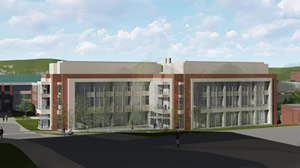New Chemistry Building for Ohio University
 Groundbreaking was held in August for a new state-of-the-art chemistry building on the campus of Ohio University in Athens, OH. The 69,000-square-foot building will feature student and faculty collaboration spaces, research laboratories, and faculty and graduate student offices. The new building is projected to open in the summer of 2020. The project is estimated to cost $42.6 million.
Groundbreaking was held in August for a new state-of-the-art chemistry building on the campus of Ohio University in Athens, OH. The 69,000-square-foot building will feature student and faculty collaboration spaces, research laboratories, and faculty and graduate student offices. The new building is projected to open in the summer of 2020. The project is estimated to cost $42.6 million.
The first floor of the new building will also include a space for shared research instrumentation, and will put research activity on display next to the undergraduate student labs. Upper floors will feature laboratories and offices, as well as collaboration and conference rooms.
The building is situated to preserve nearby old growth sycamore trees.